MERCEDES-BENZ C-CLASS ESTATE 2007 Owners Manual
Manufacturer: MERCEDES-BENZ, Model Year: 2007, Model line: C-CLASS ESTATE, Model: MERCEDES-BENZ C-CLASS ESTATE 2007Pages: 377, PDF Size: 6.19 MB
Page 301 of 377
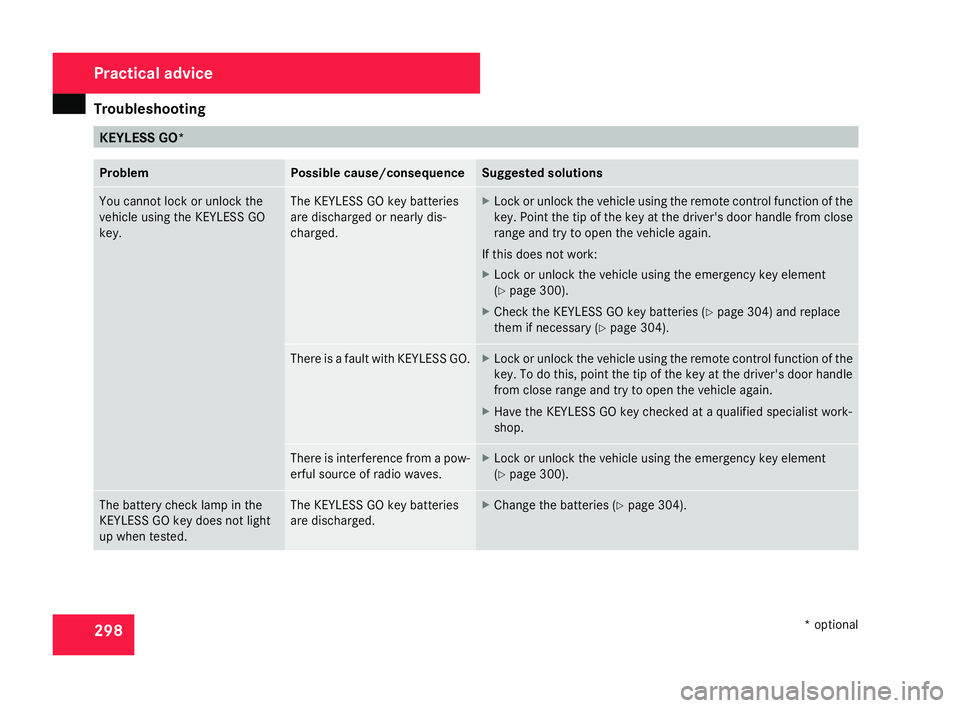
Troubleshooting
29
8 KEYLESS GO*
Problem Possible cause/consequence Suggested solutions
You cannot lock or unlock th
e
vehicle using the KEYLESS GO
key. The KEYLESS GO key batterie
s
are discharged or nearly dis-
charged. X
Lock or unlock the vehicle using the remote control function of the
key. Point the tip of the key at the driver's door handle from close
range and try to open the vehicle again.
If this does not work:
X Lock or unlock the vehicle using the emergency key element
(Y page 300).
X Check the KEYLESS GO key batteries (Y page 304) and replace
them if necessary (Y page 304). There is a fault with KEYLESS GO. X
Lock or unlock the vehicle using the remote control function of the
key. To do this, point the tip of the key at the driver's door handle
from close range and try to open the vehicle again.
X Have the KEYLESS GO key checked at a qualified specialist work-
shop . There is interference from a pow-
erful source of radio waves. X
Lock or unlock the vehicle using the emergency key element
(Y page 300). The battery check lamp in the
KEYLESS GO key does not light
up when tested. The KEYLESS GO key batteries
are discharged. X
Change the batteries (Y page 304). Practical advice
* optional
204_AKB; 2; 3, en-GB
mkalafa,
2007-06-26T23:11:51+02:00 - Seite 298
Page 302 of 377
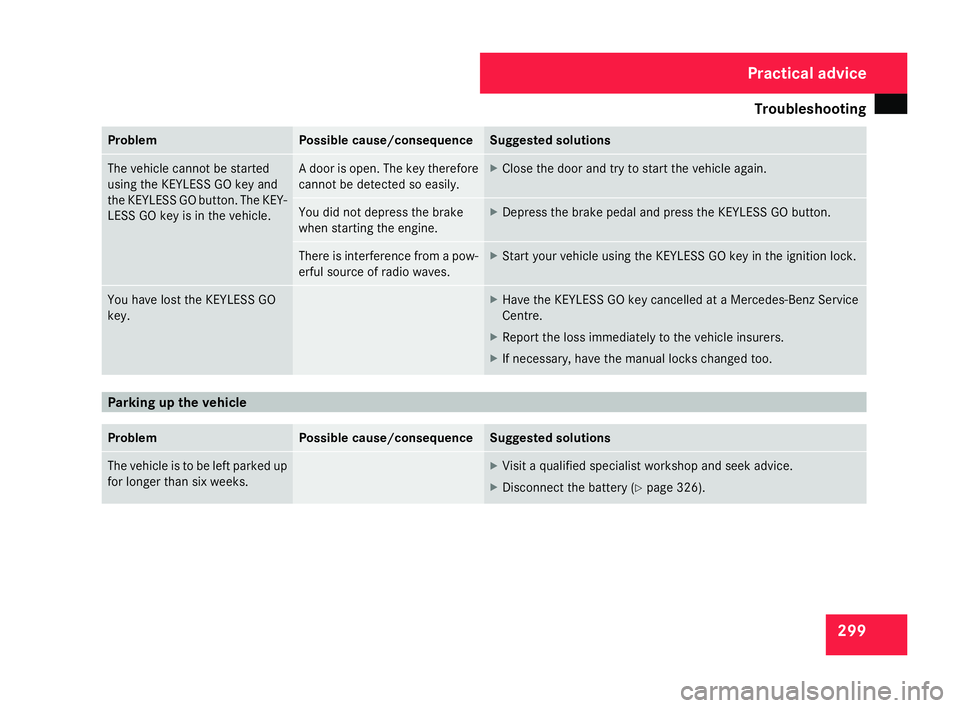
Troubleshooting
29
9 Problem Possible cause/consequence Suggested solutions
The vehicle cannot be started
using the KEYLESS GO key and
the KEYLESS GO button. The KEY-
LESS GO key is in the vehicle. A door is open. The key therefore
cannot be detected so easily. X
Close the door and try to start the vehicle again . You did not depress the brak
e
when starting the engine. X
Depress the brake pedal and press the KEYLESS GO button. There is interference from a pow-
erful source of radio waves
. X
Start your vehicle using the KEYLESS GO key in the ignition lock. You have lost the KEYLESS GO
key
. X
Have the KEYLESS GO key cancelled at a Mercedes-Benz Service
Centre.
X Report the loss immediately to the vehicle insurers .
X If necessary, have the manual locks changed too. Parking up the vehicle
Proble
m Possible cause/consequence Suggested solutions
The vehicle is to be left parked up
for longer than six weeks. X
Visit a qualified specialist workshop and seek advice.
X Disconnect the battery (Y page 326). Practical advice
204_AKB; 2; 3, en-GB
mkalafa,
2007-06-26T23:11:51+02:00 - Seite 299
Page 303 of 377
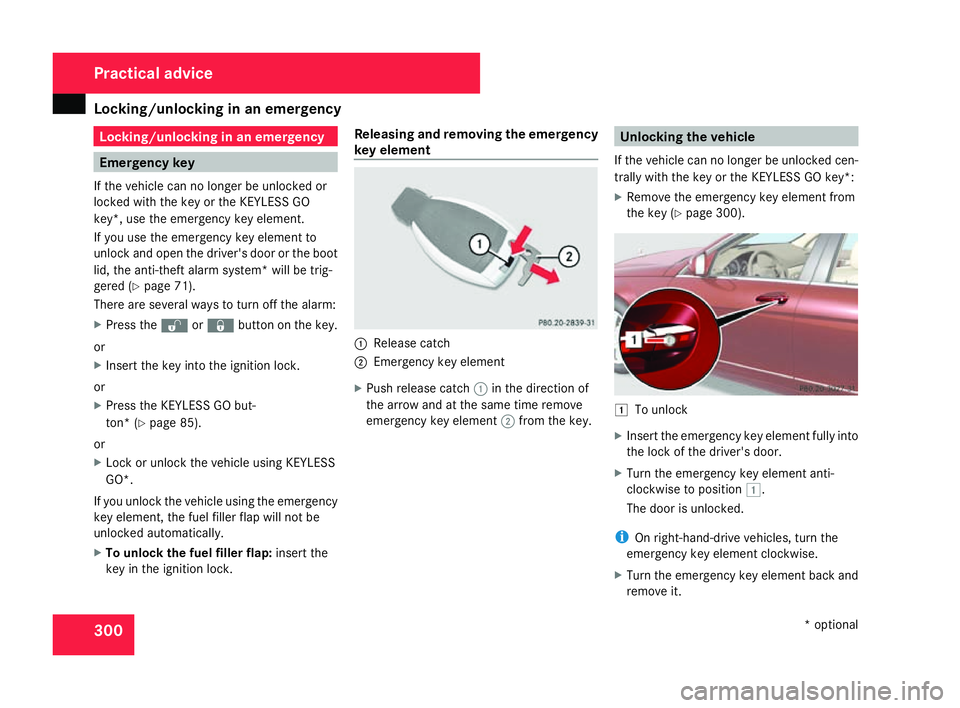
Locking/unlocking in an emergency
300 Locking/unlocking in an emergency
Emergency key
If the vehicle can no longer be unlocked or
locked with the key or the KEYLESS GO
key*, use the emergency key element.
If you use the emergency key element to
unlock and open the driver's door or the boot
lid, the anti-theft alarm system* will be trig-
gered (Y page 71).
There are several ways to turn off the alarm:
X Press the korj button on the key.
or
X Insert the key into the ignition lock.
or
X Press the KEYLESS GO but-
ton* (Y page 85).
or
X Lock or unlock the vehicle using KEYLESS
GO*.
If you unlock the vehicle using the emergency
key element, the fuel filler flap will not be
unlocked automatically.
X To unlock the fuel filler flap: insert the
key in the ignition lock. Releasing and removing the emergenc
y
key element 1
Release catch
2 Emergency key element
X Push release catch 1in the direction of
the arrow and at the same time remove
emergency key element 2from the key. Unlocking the vehicle
If the vehicle can no longer be unlocked cen-
trally with the key or the KEYLESS GO key*:
X Remove the emergency key element from
the key (Y page 300). $
To unlock
X Insert the emergency key element fully into
the lock of the driver's door.
X Turn the emergency key element anti-
clockwise to position $.
The door is unlocked.
i On right-hand-drive vehicles, turn the
emergency key element clockwise.
X Turn the emergency key element back and
remove it. Practical advice
* optional
204_AKB; 2; 3, en-GB
mkalafa,
2007-06-26T23:11:51+02:00 - Seite 300
Page 304 of 377
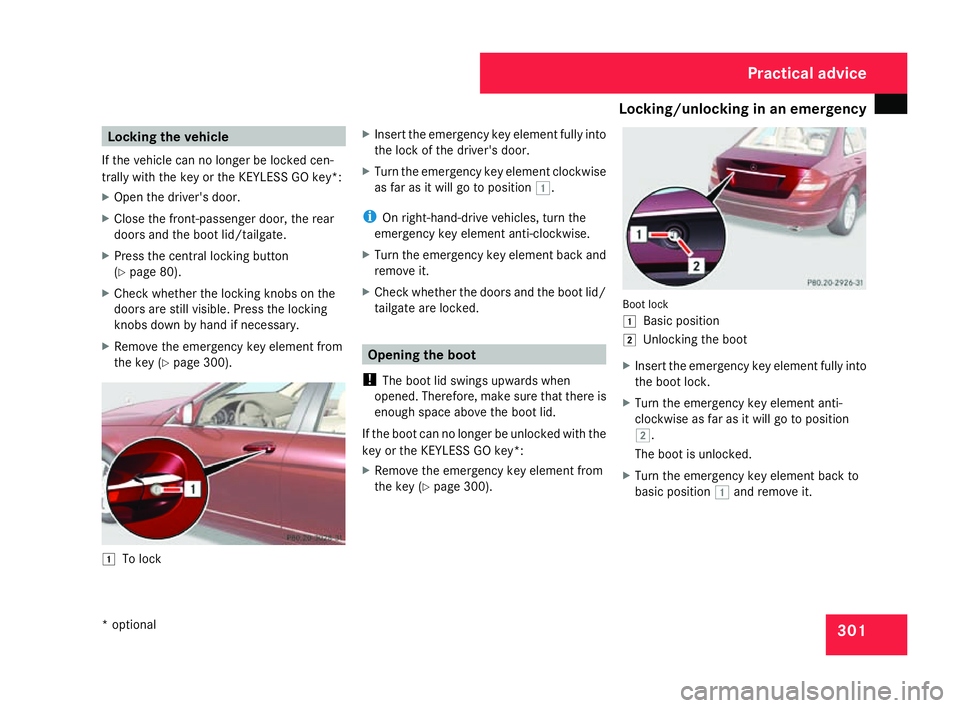
Locking/unlocking in an emergency
301Locking the vehicle
If the vehicle can no longer be locked cen -
trally with the key or the KEYLESS GO key*:
X Open the driver's door.
X Close the front-passenger door, the rear
doors and the boot lid/tailgate.
X Press the central locking button
(Y page 80).
X Check whether the locking knobs on th e
doors are still visible. Press the locking
knobs down by hand if necessary.
X Remove the emergency key element from
the key (Y page 300). $
To lock X
Insert the emergency key element fully into
the lock of the driver's door.
X Turn the emergency key element clockwise
as far as it will go to position $.
i On right-hand-drive vehicles, turn the
emergency key element anti-clockwise.
X Turn the emergency key element back and
remove it.
X Check whether the doors and the boot lid/
tailgate are locked. Opening the boot
! The boot lid swings upwards when
opened. Therefore, make sure that there is
enough space above the boot lid.
If the boot can no longer be unlocked with th e
key or the KEYLESS GO key *:
X Remove the emergency key element from
the key (Y page 300). Boot lock
$ Basic position
% Unlocking the boot
X Insert the emergency key element fully into
the boot lock.
X Turn the emergency key element anti-
clockwise as far as it will go to position
% .
The boot is unlocked.
X Turn the emergency key element back to
basic position $and remove it. Practical advice
* optional
204_AKB; 2; 3, en-GB
mkalafa
, 2007-06-26T23:11:51+02:00 - Seite 301
Page 305 of 377
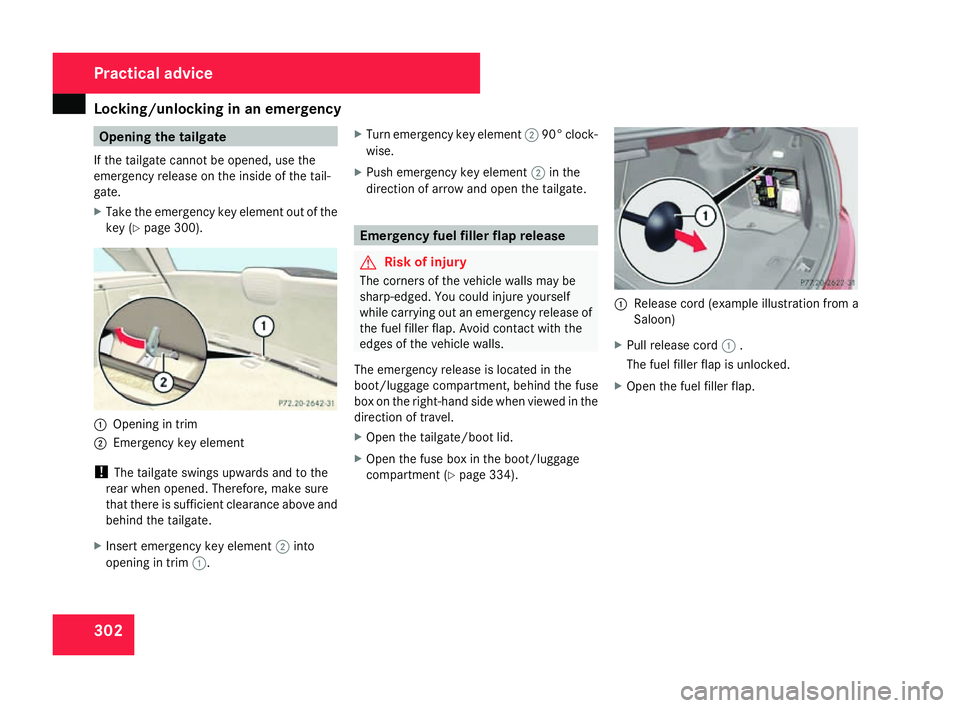
Locking/unlocking in an emergency
302 Opening the tailgate
If the tailgate cannot be opened, use th e
emergency release on the inside of the tail-
gate.
X Take the emergency key element out of the
key (Y page 300). 1
Opening in trim
2 Emergency key element
! The tailgate swings upwards and to the
rear when opened. Therefore, make sure
that there is sufficient clearance above and
behind the tailgate .
X Insert emergency key element 2into
opening in trim 1. X
Turn emergency key element 290° clock-
wise.
X Push emergency key element 2in the
direction of arrow and open the tailgate. Emergency fuel filler flap release
G
Risk of injury
The corners of the vehicle walls may be
sharp-edged. You could injure yoursel f
while carrying out an emergency release of
the fuel filler flap. Avoid contact with th e
edges of the vehicle walls.
The emergency release is located in the
boot/luggage compartment, behind the fuse
box on the right-hand side when viewed in the
direction of travel.
X Open the tailgate/boot lid.
X Open the fuse box in the boot/luggage
compartment (Y page 334). 1
Release cord (example illustration from a
Saloon)
X Pull release cord 1.
The fuel filler flap is unlocked.
X Open the fuel filler flap. Practical advice
204_AKB; 2; 3, en-GB
mkalafa,
2007-06-26T23:11:51+02:00 - Seite 302
Page 306 of 377
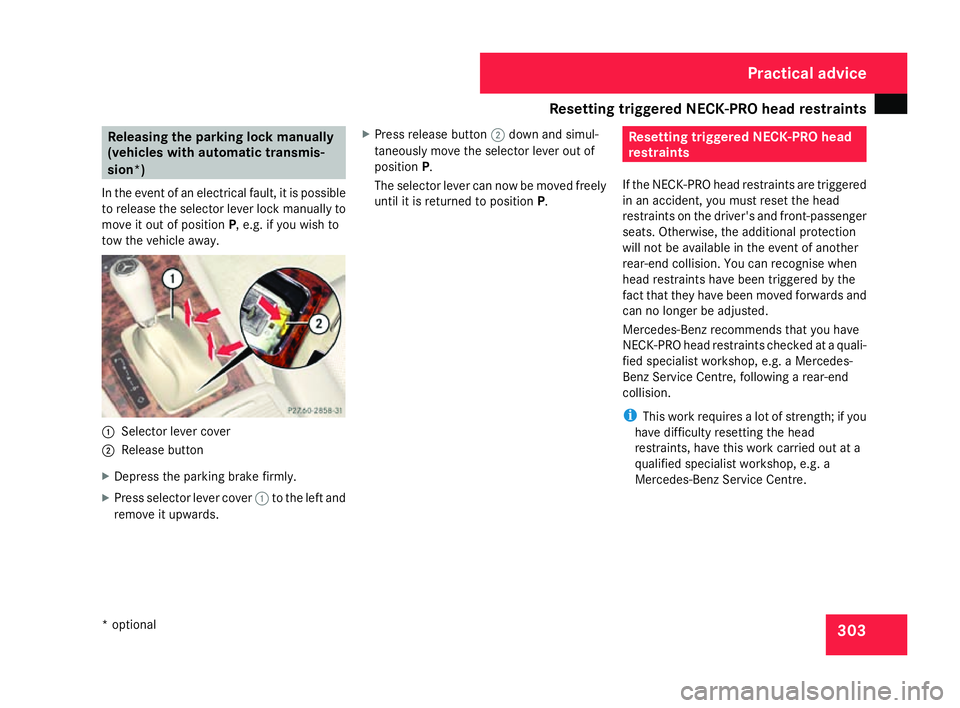
Resetting triggered NECK-PRO head restraints
30
3 Releasing the parking lock manually
(vehicles with automatic transmis-
sion*)
In the event of an electrical fault, it is possible
to release the selector lever lock manually to
move it out of position P, e.g. if you wish to
tow the vehicle away. 1
Selector lever cove r
2 Release butto n
X Depress the parking brake firmly.
X Press selector lever cover 1to the left and
remove it upwards . X
Press release button 2down and simul-
taneously move the selector lever out of
position P.
The selector lever can now be moved freely
until it is returned to position P. Resetting triggered NECK-PRO head
restraints
If the NECK-PRO head restraints are triggered
in an accident, you must reset the hea d
restraints on the driver's and front-passenge r
seats. Otherwise, the additional protection
will not be available in the event of another
rear-end collision. You can recognise when
head restraints have been triggered by the
fact that they have been moved forwards and
can no longer be adjusted.
Mercedes-Benz recommends that you have
NECK-PRO head restraints checked at a quali-
fied specialist workshop, e.g. a Mercedes-
Benz Service Centre, following a rear-end
collision.
i This work requires a lot of strength; if you
have difficulty resetting the head
restraints, have this work carried out at a
qualified specialist workshop, e.g. a
Mercedes-Benz Service Centre. Practical advice
* optional
204_AKB; 2; 3, en-GB
mkalafa,
2007-06-26T23:11:51+02:00 - Seite 303
Page 307 of 377
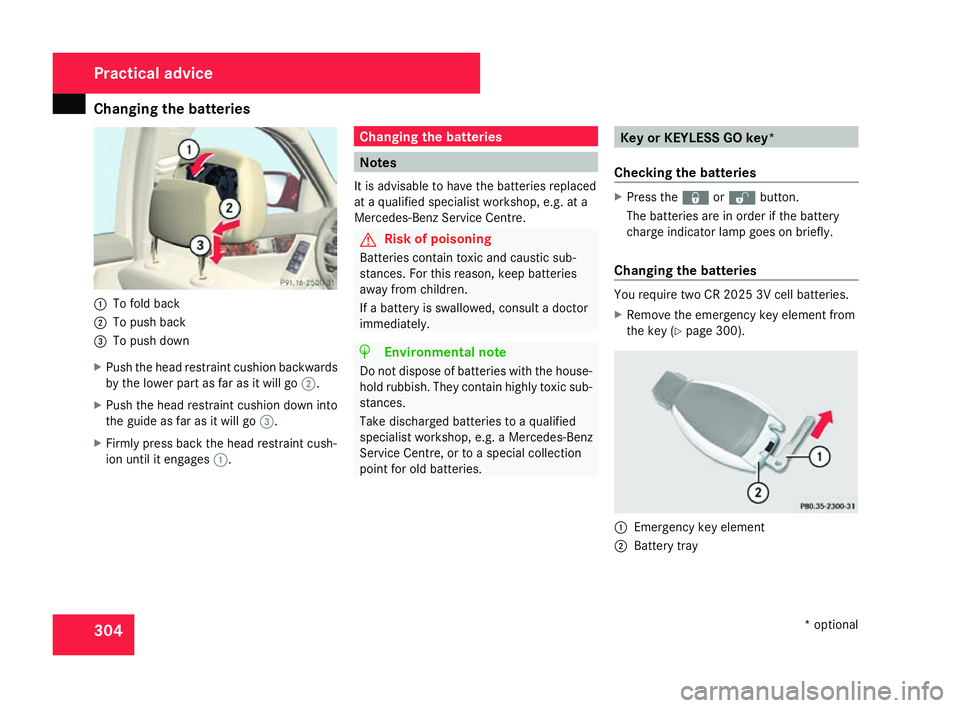
Changing the batteries
3041
To fold back
2 To push back
3 To push down
X Push the head restraint cushion backwards
by the lower part as far as it will go 2.
X Push the head restraint cushion down into
the guide as far as it will go 3.
X Firmly press back the head restraint cush -
ion until it engages 1. Changing the batteries
Notes
It is advisable to have the batteries replaced
at a qualified specialist workshop, e.g. at a
Mercedes-Benz Service Centre. G
Risk of poisoning
Batteries contain toxic and caustic sub-
stances. For this reason, keep batteries
away from children.
If a battery is swallowed, consult a docto r
immediately. H
Environmental not
e
Do not dispose of batteries with the house-
hold rubbish. They contain highly toxic sub-
stances .
Take discharged batteries to a qualified
specialist workshop, e.g. a Mercedes-Benz
Service Centre, or to a special collection
point for old batteries. Key or KEYLESS GO key*
Checking the batteries X
Press the jork button.
The batteries are in order if the battery
charge indicator lamp goes on briefly.
Changing the batteries You require two CR 2025 3V cell batteries.
X
Remove the emergency key element from
the key (Y page 300). 1
Emergency key element
2 Battery tray Practical advic
e
* optional
204_AKB; 2; 3, en-GB
mkalafa,
2007-06-26T23:11:51+02:00 - Seite 304
Page 308 of 377
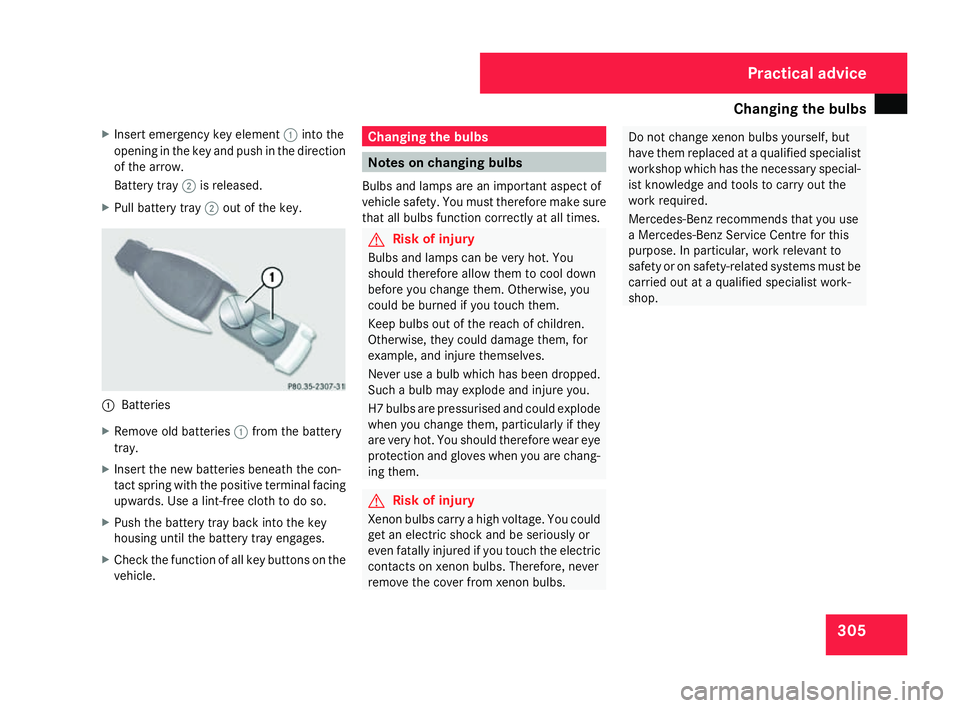
Changing the bulbs
305
X
Insert emergency key element 1into the
opening in the key and push in the direction
of the arrow.
Battery tray 2is released .
X Pull battery tray 2out of the key. 1
Batterie s
X Remove old batteries 1from the battery
tray.
X Insert the new batteries beneath the con-
tact spring with the positive terminal facing
upwards. Use a lint-free cloth to do so.
X Push the battery tray back into the key
housing until the battery tray engages.
X Check the function of all key buttons on th e
vehicle. Changing the bulbs
Notes on changing bulbs
Bulbs and lamps are an important aspect of
vehicle safety. You must therefore make sure
that all bulbs function correctly at all times. G
Risk of injury
Bulbs and lamps can be very hot. Yo u
should therefore allow them to cool down
before you change them. Otherwise, you
could be burned if you touch them.
Keep bulbs out of the reach of children.
Otherwise, they could damage them, for
example, and injure themselves.
Never use a bulb which has been dropped.
Such a bulb may explode and injure you.
H7 bulbs are pressurised and could explode
when you change them, particularly if they
are very hot. You should therefore wear eye
protection and gloves when you are chang-
ing them. G
Risk of injury
Xenon bulbs carry a high voltage. You could
get an electric shock and be seriously or
even fatally injured if you touch the electri c
contacts on xenon bulbs. Therefore, neve r
remove the cover from xenon bulbs. Do not change xenon bulbs yourself, but
have them replaced at a qualified specialist
workshop which has the necessary special-
ist knowledge and tools to carry out the
work required .
Mercedes-Benz recommends that you use
a Mercedes-Benz Service Centre for this
purpose. In particular, work relevant to
safety or on safety-related systems must be
carried out at a qualified specialist work-
shop. Practical advice
204_AKB; 2; 3, en-GB
mkalafa,
2007-06-26T23:11:51+02:00 - Seite 305
Page 309 of 377
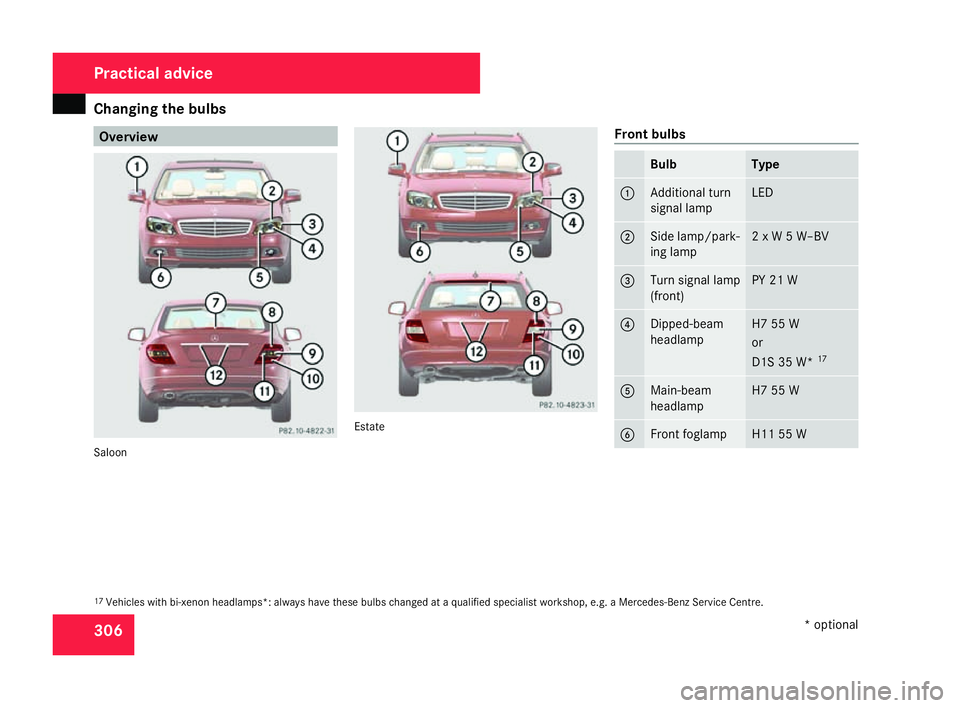
Changing the bulbs
306 Overview
Saloon Estat
e Front bulbs Bulb Type
1 Additional tur
n
signal lamp LED
2 Side lamp/park-
ing lamp 2 x W 5 W–BV
3 Turn signal lamp
(front
) PY 21
W 4 Dipped-bea
m
headlamp H7 55
W
or
D1S 35 W* 17 5 Main-beam
headlamp H7 55
W 6 Front foglamp H11 55
W 17
Vehicles with bi-xenon headlamps*: always have these bulbs changed at a qualified specialist workshop, e.g. a Mercedes-Benz Service Centre. Practical advice
* optional
204_AKB; 2; 3, en-GB
mkalafa,
2007-06-26T23:11:51+02:00 - Seite 306
Page 310 of 377
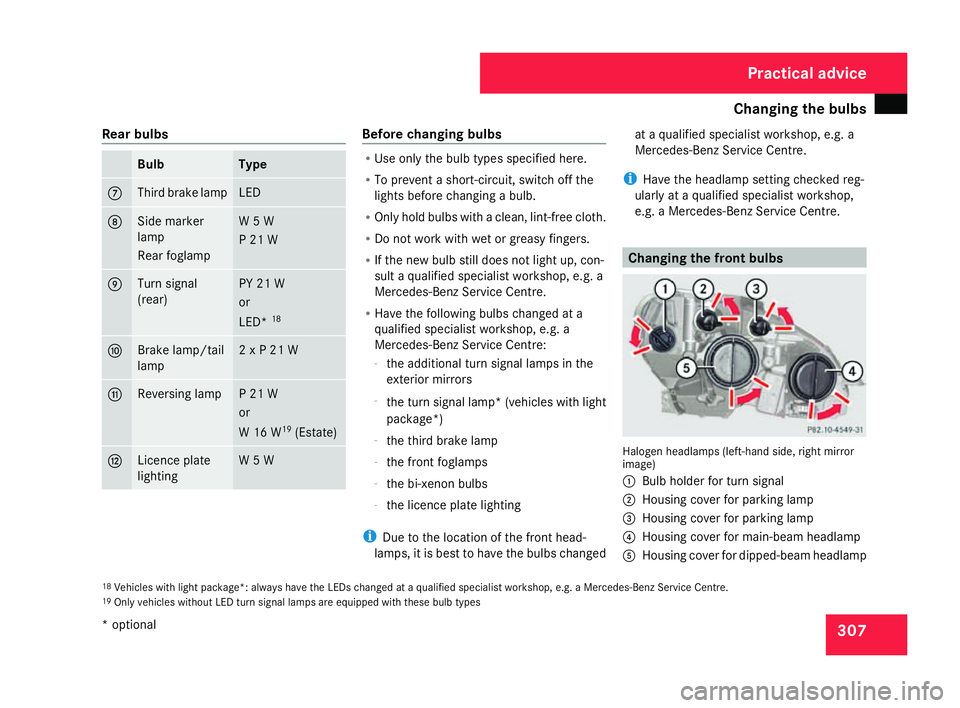
Changing the bulbs
307
Rear bulbs Bulb Type
7 Third brake lamp LED
8 Side marker
lamp
Rear foglamp W 5
W
P 21 W 9 Turn signal
(rear) PY 21
W
or
LED* 18 a Brake lamp/tail
lamp 2 x P 21
W b Reversing lamp P 21
W
or
W 16 W19
(Estate) c Licence plate
lighting W 5
W Before changing bulbs
R
Use only the bulb types specified here.
R To prevent a short-circuit, switch off the
lights before changing a bulb.
R Only hold bulbs with a clean, lint-free cloth.
R Do not work with wet or greasy fingers.
R If the new bulb still does not light up, con-
sult a qualified specialist workshop, e.g. a
Mercedes-Benz Service Centre.
R Have the following bulbs changed at a
qualified specialist workshop, e.g. a
Mercedes-Benz Service Centre:
- the additional turn signal lamps in the
exterior mirrors
- the turn signal lamp* (vehicles with ligh t
package*)
- the third brake lamp
- the front foglamps
- the bi-xenon bulb s
- the licence plate lighting
i Due to the location of the front head -
lamps, it is best to have the bulbs changed at a qualified specialist workshop, e.g.
a
Mercedes-Benz Service Centre.
i Have the headlamp setting checked reg-
ularly at a qualified specialist workshop ,
e.g. a Mercedes-Benz Service Centre. Changing the front bulbs
Halogen headlamps (left-hand side, right mirror
image)
1 Bulb holder for turn signal
2 Housing cover for parking lamp
3 Housing cover for parking lamp
4 Housing cover for main-beam headlamp
5 Housing cover for dipped-beam headlamp
18 Vehicles with light package*: always have the LEDs changed at a qualified specialist workshop, e.g. a Mercedes-Benz Service Centre.
19 Only vehicles without LED turn signal lamps are equipped with these bulb type s Practical advice
* optional
204_AKB; 2; 3, en-GB
mkalafa,
2007-06-26T23:11:51+02:00 - Seite 307